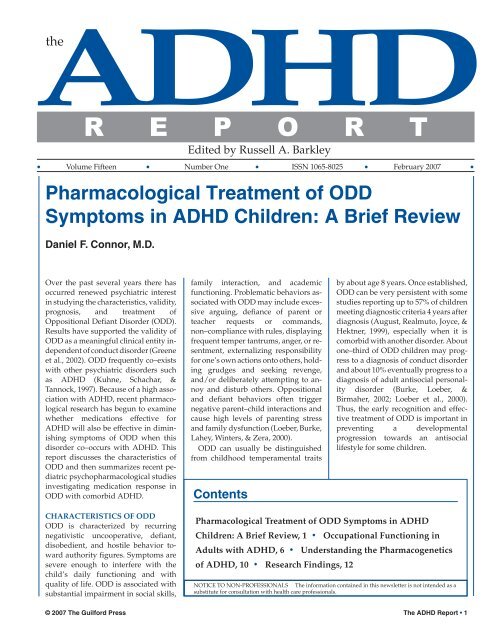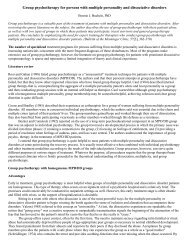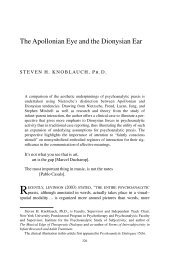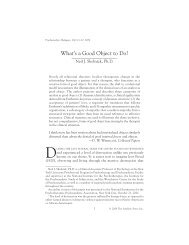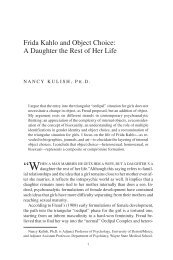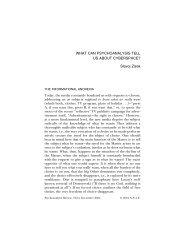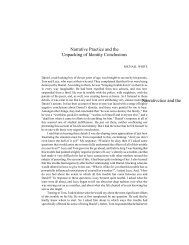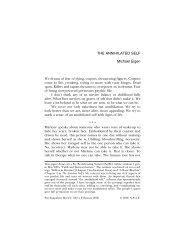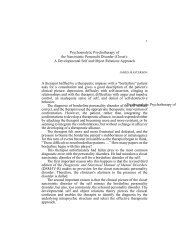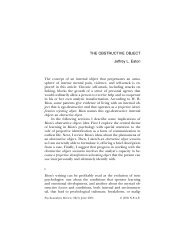Pharmacological Treatment Of ODD Symptoms In ADHD ... - PsyBC
Pharmacological Treatment Of ODD Symptoms In ADHD ... - PsyBC
Pharmacological Treatment Of ODD Symptoms In ADHD ... - PsyBC
Create successful ePaper yourself
Turn your PDF publications into a flip-book with our unique Google optimized e-Paper software.
the<br />
R E P O R T<br />
Edited by Russell A. Barkley<br />
• Volume Fifteen • Number One • ISSN 1065-8025 • February 2007 •<br />
<strong>Pharmacological</strong> <strong>Treatment</strong> of <strong>ODD</strong><br />
<strong>Symptoms</strong> in <strong>ADHD</strong> Children: A Brief Review<br />
Daniel F. Connor, M.D.<br />
Over the past several years there has<br />
occurred renewed psychiatric interest<br />
in studying the characteristics, validity,<br />
prognosis, and treatment of<br />
Oppositional Defiant Disorder (<strong>ODD</strong>).<br />
Results have supported the validity of<br />
<strong>ODD</strong> as a meaningful clinical entity independent<br />
of conduct disorder (Greene<br />
et al., 2002). <strong>ODD</strong> frequently co–exists<br />
with other psychiatric disorders such<br />
as <strong>ADHD</strong> (Kuhne, Schachar, &<br />
Tannock, 1997). Because of a high association<br />
with <strong>ADHD</strong>, recent pharmacological<br />
research has begun to examine<br />
whether medications effective for<br />
<strong>ADHD</strong> will also be effective in diminishing<br />
symptoms of <strong>ODD</strong> when this<br />
disorder co–occurs with <strong>ADHD</strong>. This<br />
report discusses the characteristics of<br />
<strong>ODD</strong> and then summarizes recent pediatric<br />
psychopharmacological studies<br />
investigating medication response in<br />
<strong>ODD</strong> with comorbid <strong>ADHD</strong>.<br />
family interaction, and academic<br />
functioning. Problematic behaviors associated<br />
with <strong>ODD</strong> may include excessive<br />
arguing, defiance of parent or<br />
teacher requests or commands,<br />
non–compliance with rules, displaying<br />
frequent temper tantrums, anger, or resentment,<br />
externalizing responsibility<br />
for one’s own actions onto others, holding<br />
grudges and seeking revenge,<br />
and/or deliberately attempting to annoy<br />
and disturb others. Oppositional<br />
and defiant behaviors often trigger<br />
negative parent–child interactions and<br />
cause high levels of parenting stress<br />
and family dysfunction (Loeber, Burke,<br />
Lahey, Winters, & Zera, 2000).<br />
<strong>ODD</strong> can usually be distinguished<br />
from childhood temperamental traits<br />
Contents<br />
by about age 8 years. Once established,<br />
<strong>ODD</strong> can be very persistent with some<br />
studies reporting up to 57% of children<br />
meeting diagnostic criteria 4 years after<br />
diagnosis (August, Realmuto, Joyce, &<br />
Hektner, 1999), especially when it is<br />
comorbid with another disorder. About<br />
one–third of <strong>ODD</strong> children may progress<br />
to a diagnosis of conduct disorder<br />
and about 10% eventually progress to a<br />
diagnosis of adult antisocial personality<br />
disorder (Burke, Loeber, &<br />
Birmaher, 2002; Loeber et al., 2000).<br />
Thus, the early recognition and effective<br />
treatment of <strong>ODD</strong> is important in<br />
preventing a developmental<br />
progression towards an antisocial<br />
lifestyle for some children.<br />
CHARACTERISTICS OF <strong>ODD</strong><br />
<strong>ODD</strong> is characterized by recurring<br />
negativistic uncooperative, defiant,<br />
disobedient, and hostile behavior toward<br />
authority figures. <strong>Symptoms</strong> are<br />
severe enough to interfere with the<br />
child’s daily functioning and with<br />
quality of life. <strong>ODD</strong> is associated with<br />
substantial impairment in social skills,<br />
<strong>Pharmacological</strong> <strong>Treatment</strong> of <strong>ODD</strong> <strong>Symptoms</strong> in <strong>ADHD</strong><br />
Children: A Brief Review, 1 Occupational Functioning in<br />
Adults with <strong>ADHD</strong>, 6 Understanding the Pharmacogenetics<br />
of <strong>ADHD</strong>, 10 Research Findings, 12<br />
NOTICE TO NON-PROFESSIONALS The information contained in this newsletter is not intended as a<br />
substitute for consultation with health care professionals.<br />
© 2007 The Guilford Press The <strong>ADHD</strong> Report • 1
Russell A. Barkley, Ph.D.<br />
Department of Psychiatry<br />
SUNY Upstate Medical University<br />
Send correspondence to:<br />
1752 Greenspoint Ct.<br />
Mount Pleasant, SC 29466<br />
E-mail: russellbarkley@earthlink.net<br />
www.russellbarkley.org<br />
EDITORIAL BOARD<br />
Arthur Anastopoulos, Ph.D., University of<br />
North Carolina at Greensboro • José J.<br />
Bauermeister, Ph.D., University of Puerto<br />
Rico, San Juan • Joseph Biederman, M.D.,<br />
Massachusetts General Hospital • Caryn<br />
Carlson, Ph.D., University of Texas, Austin •<br />
Andrea M. Chronis, Ph.D., University of<br />
Maryland, College Park • Daniel F. Connor,<br />
M.D., University of Connecticut Health Center<br />
• Charles E. Cunningham, Ph.D.,<br />
McMaster University Medical Center •<br />
George J. DuPaul, Ph.D., Lehigh University,<br />
PA • Mariellen Fischer, Ph.D., Medical College<br />
of Wisconsin, Milwaukee • Sam<br />
Goldstein, Ph.D., University of Utah, Salt<br />
Lake City • Michael Gordon, Ph.D., State<br />
University of New York Upstate Medical University<br />
• Lily Hechtman, M.D., Montreal<br />
Children’s Hospital, Montreal • Stephen<br />
Hinshaw, Ph.D., UC, Berkeley • Betsy Hoza,<br />
Ph.D., University of Vermont • James<br />
Hudziak, M.D., University of Vermont Medical<br />
Center • Charlotte Johnston, Ph.D., University<br />
of British Columbia, Vancouver •<br />
Laura Knouse, M.A., University of North<br />
Carolina, Greensboro • Rafael Klorman,<br />
Ph.D., University of Rochester, NY • Florence<br />
Levy, M.D., The Prince of Wales Children’s<br />
Hospital, Australia • Larry<br />
Lewandowski, Ph.D., Syracuse University,<br />
NY • Sandra Loo, Ph.D., Neuropsychiatric<br />
<strong>In</strong>stitute, UCLA • Richard Milich, Ph.D.,<br />
University of Kentucky, Lexington • Kevin<br />
Murphy, Ph.D., Adult <strong>ADHD</strong> Clinic of Central<br />
Massachusetts • Joel Nigg, Ph.D., Michigan<br />
State University, East Lansing • William<br />
Pelham, Ph.D., SUNY, Buffalo • Linda<br />
Pfiffner, Ph.D., University of Chicago • Stephen<br />
Pliszka, M.D., University of Texas<br />
Medical School, San Antonio • Mark Rapport,<br />
Ph.D., University of Central Florida •<br />
Russell Schachar, M.D., The Hospital for Sick<br />
Children, Toronto • Bradley Smith, Ph.D.,<br />
University of South Carolina, Columbia •<br />
Thomas Spencer, M.D., Massachusetts General<br />
Hospital • Mark Stein, Ph.D., University<br />
of Illinois, Chicago • Rosemary Tannock,<br />
Ph.D., Hospital for Sick Children, Toronto •<br />
Lisa Weyandt, Ph.D., Central Washington<br />
University • Thomas E. Wilens, M.D., Massachusetts<br />
General Hospital • Alan Zametkin,<br />
M.D., National <strong>In</strong>stitute of Mental Health,<br />
Bethesda<br />
<br />
THE <strong>ADHD</strong> REPORT (ISSN 1065-8025) is published bimonthly<br />
by The Guilford Press, 72 Spring Street, New York, NY 10012.<br />
Periodicals postage paid at New York, NY, and at additional<br />
mailing offices. Guilford’s GST registration number: 137401014.<br />
Subscription price: (six issues) <strong>In</strong>dividuals $79.00, <strong>In</strong>stitutions,<br />
$175.00. Add $10.00 for Canada and Foreign (includes airmail<br />
postage). Orders by MasterCard, VISA, or American Express can<br />
be placed by phone at 800-365-7006, Fax 212-966-6708, or E-mail<br />
news@guilford.com; in New York, 212-431-9800. Payment must<br />
be made in U.S. dollars through a U.S. bank. All prices quoted in<br />
U.S. dollars. Pro forma invoices issued upon request.<br />
Visit our website at www.guilford.com.<br />
CHANGE OF ADDRESS: Please inform publisher at least six<br />
weeks prior to move. Enclose mailing label with change of address.<br />
Claims for lost issues cannot be honored four months after<br />
mailing date. Duplicate copies cannot be sent to replace issues not<br />
delivered because of failure to notify publisher of change of address.<br />
Postmaster: Change of address to The <strong>ADHD</strong> Report,<br />
Guilford Press, 72 Spring Street, New York, NY 10012.<br />
Photocopying of this newsletter is not permitted.<br />
<strong>In</strong>quire for bulk rates.<br />
Copyright © 2007 by The Guilford Press.<br />
Printed in the United States of America.<br />
PREVALENCE OF <strong>ODD</strong><br />
WITH/WITHOUT <strong>ADHD</strong><br />
The prevalence of <strong>ODD</strong> in the general<br />
population is about 8.5% (Kessler et al.,<br />
2005). Children and adolescents with<br />
<strong>ODD</strong> have high rates of comorbid psychiatric<br />
disorders. <strong>In</strong> non–referred population-based<br />
studies of <strong>ODD</strong> youths,<br />
comorbid <strong>ADHD</strong> rates ranging between<br />
14% and 35% are reported<br />
(Angold, Costello, & Erkanli, 1999; Bird<br />
et al., 1988). It is generally agreed that<br />
oppositional defiant disorder is the<br />
most common comorbidity in psychiatric<br />
samples of <strong>ADHD</strong> children and, in<br />
clinically referred children, the<br />
comorbidity rates of <strong>ODD</strong> and <strong>ADHD</strong><br />
are much higher than in non–referred<br />
populations. <strong>ADHD</strong> and <strong>ODD</strong> may<br />
overlap in up to 65% of clinically referred<br />
<strong>ADHD</strong> children (Biederman et<br />
al., 1996).<br />
THE RELATIONSHIP BETWEEN<br />
<strong>ADHD</strong> AND <strong>ODD</strong><br />
Several studies have examined the relationship<br />
between <strong>ADHD</strong> and <strong>ODD</strong> in<br />
clinically referred children and adolescents.<br />
There appears to be a correlation<br />
between the severity of <strong>ADHD</strong> symptoms<br />
and the severity of <strong>ODD</strong> symptoms<br />
as measured by rating scale<br />
scores. If diagnostic criteria are met for<br />
both <strong>ADHD</strong> and <strong>ODD</strong>, as the severity<br />
of <strong>ADHD</strong> symptoms worsen (based on<br />
the number of symptoms endorsed),<br />
<strong>ODD</strong> symptoms are also likely to become<br />
more severe (Kuhne et al., 1997).<br />
<strong>ODD</strong> is a significant correlate of family<br />
psychopathology and adverse social<br />
outcomes in <strong>ADHD</strong> children compared<br />
to children with <strong>ADHD</strong> alone, even<br />
when other comorbid disorders are<br />
controlled (Greene et al., 2002). <strong>In</strong> general,<br />
<strong>ADHD</strong> children with comorbid<br />
<strong>ODD</strong> have higher rates of<br />
psychopathology across a number of<br />
domains compared to youths with<br />
<strong>ADHD</strong> alone, but less than those with<br />
<strong>ADHD</strong> + conduct disorder (Burke et al.,<br />
2002; Loeber et al., 2000).<br />
Aggression is a domain of<br />
psychopathology that often causes parents<br />
to refer their child for clinical evaluation<br />
and treatment. Overt aggression<br />
is defined as aggression resulting in a<br />
direct confrontation with the environment.<br />
Overt aggression includes such<br />
behaviors as threats towards others,<br />
self–injurious behaviors, explosive acts<br />
of property destruction, and physical<br />
fighting with others. Covert aggression<br />
is hidden and furtive. It may involve<br />
behaviors such as delinquency, lying,<br />
shoplifting, and cheating. <strong>In</strong> the<br />
DSM–IV nosology of psychiatric disorders,<br />
children with high rates of overt<br />
and covert aggression are generally assigned<br />
a diagnosis of conduct disorder.<br />
Despite the absence of overt and/or covert<br />
aggression as a diagnostic criterion<br />
for <strong>ODD</strong>, recent research has documented<br />
significantly higher rates of<br />
overt and covert aggression in <strong>ADHD</strong><br />
children with comorbid <strong>ODD</strong> compared<br />
to children with <strong>ADHD</strong> alone<br />
(Connor & Doerfler, unpublished). This<br />
is illustrated in Figures 1 and 2.<br />
Figure 1 illustrates findings using the<br />
parent–report Modified Overt Aggression<br />
Scale (MOAS) (Yudofsky, Silver,<br />
Jackson, Endicott, & Williams, 1986) in<br />
<strong>ADHD</strong> children with/without<br />
comorbid <strong>ODD</strong>. The MOAS provides<br />
an overt aggression total score, and has<br />
subscales for self–injurious behavior,<br />
verbal threats of violence directed towards<br />
others, property destruction,<br />
and physical fighting. <strong>In</strong> a clinic-referred<br />
population of male <strong>ADHD</strong> children<br />
and adolescents, those with<br />
<strong>ADHD</strong> alone (N = 61) were compared<br />
to those with <strong>ADHD</strong> and <strong>ODD</strong> (N = 83).<br />
As Figure 1 illustrates, significantly<br />
higher rates of overt aggression were<br />
found for the comorbid <strong>ADHD</strong> + <strong>ODD</strong><br />
group.<br />
Figure 2 illustrates findings from the<br />
parent–completed Child Behavior<br />
Checklist (CBCL) narrow band Aggression<br />
and Delinquency subscales. Similar<br />
to findings from the MOAS, significantly<br />
elevated rates of overt<br />
aggression and delinquency were<br />
found in the <strong>ADHD</strong> + <strong>ODD</strong> group compared<br />
to the <strong>ADHD</strong> alone group. These<br />
data suggest that both overt and covert<br />
aggression may be significant clinical<br />
problems in referred <strong>ADHD</strong> + <strong>ODD</strong><br />
children and adolescents (who are<br />
without conduct disorder) despite the<br />
absence of criteria for aggression in the<br />
2 • The <strong>ADHD</strong> Report © 2007 The Guilford Press
35<br />
30<br />
25<br />
20<br />
15<br />
10<br />
5<br />
0<br />
Total MOAS<br />
DSM–IV diagnostic symptom set for<br />
<strong>ODD</strong>.<br />
TREATMENT OF <strong>ADHD</strong> AND<br />
COMORBID <strong>ODD</strong><br />
Because of high rates of overlap between<br />
<strong>ODD</strong> and <strong>ADHD</strong> in clinical samples<br />
and because comorbid <strong>ADHD</strong> and<br />
<strong>ODD</strong> often results in higher rates of<br />
psychopathology resulting in clinical<br />
referral, clinicians who evaluate and<br />
treat children with <strong>ADHD</strong> are often<br />
faced with assessing and managing<br />
comorbid <strong>ODD</strong>. Behavioral therapy is<br />
the mainstay of treatment for <strong>ODD</strong>.<br />
Parent management training (PMT)<br />
programs have been extensively studied<br />
and found effective, especially for<br />
younger <strong>ODD</strong> patients (Barkley, 1997).<br />
However, there are several problems<br />
with this form of behavioral therapy for<br />
<strong>ODD</strong>. Effectiveness of PMT programs<br />
appears to diminish as children age<br />
into pre–adolescence. Thus, PMT programs<br />
are best suited for younger <strong>ODD</strong><br />
children. The effectiveness of PMT appears<br />
to diminish as the severity of<br />
<strong>ADHD</strong> and <strong>ODD</strong> increases. Since the<br />
severity of <strong>ODD</strong> covaries with the severity<br />
of <strong>ADHD</strong>, and comorbidity is associated<br />
with higher rates of aggressive<br />
behavior, PMT might be less effective in<br />
comorbid children than IN those with<br />
SIB<br />
<strong>ADHD</strong><br />
<strong>ADHD</strong> + <strong>ODD</strong><br />
VERBAL THREATS<br />
PROPERTY DEST<br />
AGGRESSION<br />
FIGURE 1. Overt Aggression Scale raw scores in clinically referred <strong>ADHD</strong> children and<br />
adolescents with/without comorbid <strong>ODD</strong>. MOAS (modified overt aggression scale)<br />
total score, SIB (self-injurious behavior), verbal threats of harm directed towards others,<br />
explosive acts of property destruction, and physical aggression (fighting).<br />
mild <strong>ADHD</strong> or just <strong>ODD</strong> alone. Finally,<br />
community practitioners may be untrained<br />
in the use of empirical<br />
interventions such as PMT and thus,<br />
effective PMT may be difficult to access<br />
in the community.<br />
T-Score<br />
68<br />
66<br />
64<br />
62<br />
60<br />
58<br />
56<br />
54<br />
52<br />
CBCL Aggression<br />
MEDICATION TREATMENT<br />
OF <strong>ODD</strong><br />
Although no medication is currently<br />
approved for treatment of <strong>ODD</strong>, several<br />
randomized controlled efficacy<br />
and open effectiveness trials have examined<br />
the effects of various stimulants<br />
and atomoxetine in the treatment<br />
of <strong>ODD</strong>, usually in the context of co–occurring<br />
<strong>ADHD</strong>. These studies are<br />
presented in Table 1.<br />
Three recent studies investigated<br />
stimulants for <strong>ODD</strong> symptoms in<br />
<strong>ADHD</strong> children and adolescents, many<br />
of whom also had a comorbid diagnosis<br />
of <strong>ODD</strong> (MTA Group, 1999; Spencer<br />
et al., 2006; Steele et al., 2006). <strong>In</strong> the<br />
landmark Multimodal <strong>Treatment</strong><br />
Study of Children with <strong>ADHD</strong> (MTA<br />
Study), 40% of <strong>ADHD</strong> children also<br />
met baseline diagnostic criteria for<br />
<strong>ODD</strong> (MTAGroup, 1999). With an average<br />
methylphenidate immediate release<br />
(IR MPH) dose range between<br />
30.2 mg/day and 41.3 mg/day (depending<br />
on treatment arm) given in<br />
three divided daily doses, children receiving<br />
medication management or<br />
medication management and behavioral<br />
therapy experienced a significantly<br />
greater improvement in <strong>ODD</strong><br />
symptoms than did children assigned<br />
to behavior therapy alone. Another<br />
study investigated mixed amphetamine<br />
salts extended release (MAS XR)<br />
in children and adolescents with either<br />
<strong>ODD</strong> alone (21%) or <strong>ADHD</strong> and <strong>ODD</strong><br />
(79%) (Spencer et al., 2006). Parent<br />
<strong>ODD</strong> ratings significantly improved on<br />
daily doses of 30 mg or 40 mg compared<br />
with placebo in the comorbid<br />
<strong>ADHD</strong> + <strong>ODD</strong> group. <strong>In</strong> the comorbid<br />
<strong>ADHD</strong><br />
<strong>ADHD</strong> + <strong>ODD</strong><br />
CBCL Delinquency<br />
FIGURE 2. Parent report Child Behavior Checklist Aggression and Delinquency<br />
T-scores in clinically referred <strong>ADHD</strong> children and adolescents with/without comorbid<br />
<strong>ODD</strong>. *p 0.01.<br />
© 2007 The Guilford Press The <strong>ADHD</strong> Report • 3
TABLE 1. Recent Randomized Efficacy and Effectiveness Trials Targeting <strong>ODD</strong> in <strong>ADHD</strong> Children and Adolescents<br />
Study <strong>ADHD</strong> Subjects <strong>ODD</strong> Drug Dose Duration <strong>ODD</strong> Measures Outcome<br />
Hazell, Zhang,<br />
Wolanczyk, et al.,<br />
2006<br />
Kaplan, Heiligenstein,<br />
West, et al., 2004<br />
MTA Cooperative<br />
Group, 1999<br />
Newcorn, Spencer,<br />
Biederman, et al.,<br />
2005<br />
Spencer, Abikoff,<br />
Connor, et al., 2006<br />
Steele, Weiss,<br />
Swanson, et al., 2006<br />
n = 416; 6–15 years 43% <strong>ADHD</strong> + <strong>ODD</strong> Atomoxetine 0.5–1.8 mg/kg/d Time to<br />
relapse<br />
KSADS–PL<br />
diagnosis of<br />
<strong>ODD</strong><br />
n = 98; 7–13 years 100% <strong>ADHD</strong> + <strong>ODD</strong> Atomoxetine 1.6 mg/kg/d 9 weeks CPRS–R:S (<strong>ODD</strong><br />
subscale)<br />
n = 256; 7–9.9 years 40% <strong>ADHD</strong> + <strong>ODD</strong> IR MPH tid Average dose at<br />
endpoint = 30.2 –<br />
41.3 mg/d<br />
14 months SNAP <strong>ODD</strong><br />
parent and<br />
teacher rating<br />
scales<br />
n = 297; 8–18 years 39% <strong>ADHD</strong> + <strong>ODD</strong> Atomoxetine 0.5, 1.2, 1.8 mg/kg/d 8 weeks CPRS–R:S (<strong>ODD</strong><br />
subscale)<br />
n = 308; 6–17 years 21% pure <strong>ODD</strong>; 79%<br />
<strong>ADHD</strong> + <strong>ODD</strong><br />
n = 147; 6–12 years 41% <strong>ADHD</strong> + <strong>ODD</strong> OROS–MPH<br />
versus IR<br />
MPH tid<br />
MAS XR 10, 20, 30, 40 mg/d 4 weeks SNAP–IV <strong>ODD</strong><br />
parent rating<br />
scale<br />
Average Dose:<br />
OROS–MPH = 37.8<br />
mg/d; IR MPH tid =<br />
33.3 mg/d<br />
8 weeks SNAP–IV parent<br />
rating scale<br />
Comorbid <strong>ODD</strong> does<br />
not influence rate of<br />
relapse of pts with<br />
<strong>ADHD</strong> given<br />
atomoxetine<br />
No significant<br />
difference<br />
Combination med<br />
mgt and behav =<br />
med mgt alone ><br />
behav alone<br />
<strong>ADHD</strong> + <strong>ODD</strong><br />
improved 1.8 > 1.2 =<br />
0.5 mg/kg/d<br />
MAS XR 30mg and 40<br />
mg arms > placebo<br />
on parent <strong>ODD</strong><br />
ratings<br />
<strong>ADHD</strong> + <strong>ODD</strong><br />
improved<br />
OROS–MPH > IR<br />
MPH tid<br />
<strong>ADHD</strong> + <strong>ODD</strong> group, lower MAS XR<br />
doses of 10 mg/day or 20 mg/day were<br />
not significantly different from placebo<br />
on <strong>ODD</strong> measures. The “pure” <strong>ODD</strong><br />
group did not improve on MAS XR at<br />
any dose relative to placebo (Spencer et<br />
al., 2006). This study suggests that<br />
“pure” <strong>ODD</strong> in the absence of<br />
comorbid <strong>ADHD</strong> might not be medication<br />
responsive, although more studies<br />
are needed because of the small sample<br />
size of the <strong>ODD</strong> alone group in this<br />
study. Additionally, results suggest<br />
that higher MAS XR doses might be<br />
necessary when treating comorbid<br />
<strong>ODD</strong> than when treating <strong>ADHD</strong> alone.<br />
Finally, a randomized, open–label effectiveness<br />
study compared a long–acting<br />
stimulant OROS–MPH with MPH<br />
immediate release given three times<br />
daily on <strong>ADHD</strong> and <strong>ODD</strong> outcomes<br />
(Steele et al., 2006). <strong>In</strong> this study 41% of<br />
subjects had comorbid <strong>ADHD</strong> + <strong>ODD</strong>.<br />
Results showed that the longer-acting<br />
OROS preparation improved <strong>ADHD</strong><br />
and <strong>ODD</strong> symptoms to a significantly<br />
greater degree on parent report measures<br />
than did IR MPH given in three<br />
divided daily doses. These studies suggest<br />
that <strong>ODD</strong> symptoms may be responsive<br />
to a variety of stimulant preparations,<br />
that higher doses may be necessary<br />
to diminish comorbid <strong>ODD</strong><br />
symptoms when they occur in the context<br />
of <strong>ADHD</strong>, and that longer–acting<br />
stimulant preparations may have<br />
better effectiveness on parent–report<br />
<strong>ODD</strong> measures than IR MPH even<br />
when given in multiple daily doses.<br />
Although further research is needed,<br />
these studies also raise a question as to<br />
whether <strong>ODD</strong> in the absence of<br />
comorbid <strong>ADHD</strong> is medication<br />
responsive.<br />
Atomoxetine is a nonstimulant agent<br />
approved by the U.S. Food and Drug<br />
Administration (FDA) for the treatment<br />
of <strong>ADHD</strong> in children, adolescents,<br />
and adults. A number of recent<br />
studies suggest that atomoxetine may<br />
improve <strong>ODD</strong> symptoms when they<br />
are comorbid with <strong>ADHD</strong> (see Table 1).<br />
A study examined the effects of<br />
atomoxetine on <strong>ODD</strong> symptoms in a<br />
sample of children and adolescents<br />
ages 8 to 18 with <strong>ADHD</strong> and <strong>ODD</strong><br />
(Newcorn, Spencer, Biederman, Milton,<br />
& Michelson, 2005). These investigators<br />
found that youths with <strong>ADHD</strong><br />
and comorbid <strong>ODD</strong> showed statistically<br />
significant improvement in<br />
<strong>ADHD</strong>, <strong>ODD</strong>, and quality–of–life measures.<br />
The study authors concluded<br />
that atomoxetine treatment improves<br />
<strong>ADHD</strong> and <strong>ODD</strong> symptoms in youths<br />
with <strong>ADHD</strong> and <strong>ODD</strong>, although the<br />
comorbid group may require higher<br />
atomoxetine doses of up to 1.8<br />
mg/kg/day. A randomized controlled<br />
discontinuation study examined the<br />
time to relapse in children with <strong>ADHD</strong><br />
and <strong>ODD</strong> who were previous responders<br />
to open–label atomoxetine. Responders<br />
were randomly assigned<br />
atomoxetine continuation or placebo<br />
(Hazell et al., 2006). Time to <strong>ADHD</strong> relapse<br />
was not influenced by the presence<br />
or absence of comorbid <strong>ODD</strong>. A<br />
negative randomized controlled trial<br />
was reported in which atomoxetine in<br />
doses up to 1.6 mg/kg/day did not<br />
separate from placebo on parent-report<br />
<strong>ODD</strong> measures in comorbid <strong>ADHD</strong> +<br />
<strong>ODD</strong> children (Kaplan et al., 2004). Finally,<br />
a post–hoc meta–analysis was<br />
performed to determine the effect of<br />
the presence of comorbid <strong>ODD</strong> symptoms<br />
on clinical outcomes in <strong>ADHD</strong><br />
outpatients aged 6–16 from three previously<br />
completed randomized con-<br />
4 • The <strong>ADHD</strong> Report © 2007 The Guilford Press
trolled atomoxetine trials (Biederman<br />
et al., 2007). <strong>Of</strong> the 512 <strong>ADHD</strong> subjects<br />
studied, 158 (31%) were diagnosed<br />
with comorbid <strong>ODD</strong>. Relative to placebo,<br />
atomoxetine treatment significantly<br />
reduced <strong>ADHD</strong> symptoms in<br />
both <strong>ODD</strong>–comorbid and<br />
noncomorbid subjects irrespective of<br />
the comorbidity with <strong>ODD</strong>. This<br />
meta–analysis also showed that<br />
reduction in <strong>ODD</strong> symptoms was<br />
highly correlated (0.78) to the<br />
magnitude of <strong>ADHD</strong> response to<br />
atomoxetine.<br />
SUMMARY<br />
Comorbid <strong>ODD</strong> is highly prevalent<br />
among children and adolescents clinically<br />
referred for <strong>ADHD</strong>. Comorbid<br />
youngsters have greater <strong>ADHD</strong> symptom<br />
severity, more psychopathology,<br />
and greater impairment than children<br />
with either <strong>ADHD</strong> or <strong>ODD</strong> alone.<br />
There appears to be a linear relationship<br />
between the severity of <strong>ADHD</strong><br />
and <strong>ODD</strong> symptom severity in clinically<br />
referred children. Despite the absence<br />
of criteria for overt/covert<br />
aggression in the DSM–IV symptom set<br />
for <strong>ODD</strong>, clinicians should be aware<br />
that higher rates of overt and covert aggression<br />
may be found in non-conduct-disordered<br />
clinically referred<br />
comorbid <strong>ADHD</strong> + <strong>ODD</strong> children than<br />
in referred children with <strong>ADHD</strong> alone.<br />
An emerging literature suggests that<br />
<strong>ODD</strong> symptoms may be responsive to<br />
the same medications used to treat<br />
<strong>ADHD</strong> when both disorders are<br />
comorbid in the same patient. However,<br />
it is presently unclear whether<br />
<strong>ODD</strong> in the absence of comorbid<br />
<strong>ADHD</strong> is responsive to medication.<br />
Pure <strong>ODD</strong> without concomitant<br />
<strong>ADHD</strong> remains a target for behavioral<br />
therapy intervention and parent management<br />
training. When using medication<br />
for comorbid <strong>ADHD</strong> + <strong>ODD</strong>, the<br />
practicing clinician should be aware of<br />
the following points:<br />
• Higher doses of medication may be<br />
necessary to treat comorbid <strong>ODD</strong><br />
symptoms in <strong>ADHD</strong> patients than<br />
are needed for <strong>ADHD</strong> symptoms<br />
alone.<br />
• Longer–acting stimulant preparations<br />
may have greater effectiveness<br />
on parent-report <strong>ODD</strong> symptoms<br />
than immediate release stimulant<br />
preparations given multiple times<br />
daily.<br />
• Comorbid <strong>ODD</strong> does not seem to influence<br />
the response of <strong>ADHD</strong> to<br />
medications.<br />
• Response of <strong>ODD</strong> symptoms to medication<br />
in comorbid patients appears<br />
highly correlated with medication effectiveness<br />
for <strong>ADHD</strong> symptoms.<br />
Dr. Connor is a member of the Editorial<br />
Board of The <strong>ADHD</strong> Report. He is also Director<br />
of the Division of Child and Adolescent<br />
Psychiatry and Professor in the<br />
Department of Psychiatry (MC 1410),<br />
University of Connecticut Health Care,<br />
263 Farmington Avenue, Farmington, CT<br />
06030–1410. He can be reached at:<br />
connor@psychiatry.uchc.edu.<br />
REFERENCES<br />
Angold, A., Costello, E. J., & Erkanli, A.<br />
(1999). Comorbidity. Journal of Child Psychology<br />
and Psychiatry, 40(1), 57–87.<br />
August, G. J., Realmuto, G. M., Joyce, T., &<br />
Hektner, J. M. (1999). Persistence and<br />
desistance of oppositional defiant disorder<br />
in a community sample of children with<br />
<strong>ADHD</strong>. Journal of the American Academy of<br />
Child & Adolescent Psychiatry, 38(10),<br />
1262–1270.<br />
Barkley, R. A. (1997). Defiant Children: A Clinician’s<br />
Manual for Assessment and Parent<br />
Training (2nd ed.). New York: Guilford.<br />
Biederman, J., Faraone, S. V., Milberger, S.,<br />
Jetton, J. G., Chen, L., Mick, E., et al. (1996).<br />
Is childhood oppositional defiant disorder<br />
a precursor to adolescent conduct disorder?<br />
Findings from a four–year follow–up study<br />
of children with <strong>ADHD</strong>. Journal of the American<br />
Academy of Child & Adolescent Psychiatry,<br />
35(9), 1193–1204.<br />
Biederman, J., Spencer, T. J., Newcorn, J. H.,<br />
Gao, H., Milton, D. R., Feldman, P. D., et al.<br />
(2007). Effect of comorbid symptoms of<br />
oppositional defiant disorder on responses<br />
to atomoxetine in children with <strong>ADHD</strong>: A<br />
meta–analysis of controlled clinical trial<br />
data. Psychopharmacology, 190, 31–41.<br />
Bird, H. R., Canino, G., Rubio–Stipec, M.,<br />
Gould, M. S., Ribera, J., Sesman, M., et al.<br />
(1988). Estimates of the prevalence of<br />
childhood maladjustment in a community<br />
survey in Puerto Rico. Archives of General<br />
Psychiatry, 45, 1120–1126.<br />
Burke, J. D., Loeber, R., & Birmaher, B.<br />
(2002). Oppositional defiant disorder and<br />
conduct disorder: A review of the past 10<br />
years, Part II. Journal of the American Academy<br />
of Child & Adolescent Psychiatry, 41(11),<br />
1275–1293.<br />
Greene, R. W., Biederman, J., Zerwas, S.,<br />
Monuteaux, M. C., Goring, J. C., & Faraone,<br />
S. V. (2002). Psychiatric comorbidity, family<br />
dysfunction, and social impairment in referred<br />
youth with oppositional defiant disorder.<br />
American Journal of Psychiatry, 159(7),<br />
1214–1224.<br />
Hazell, P., Zhang, S., Wolanczyk, T., Barton,<br />
J., Johnson, M., Zuddas, A., et al. (2006).<br />
Comorbid oppositional defiant disorder<br />
and the risk of relapse during 9 months of<br />
atomoxetine treatment for attention–deficit/hyperactivity<br />
disorder. European Child &<br />
Adolescent Psychiatry, 15(2), 105–110.<br />
Kaplan, S., Heiligenstein, J., West, S.,<br />
Busner, J., Harder, D., Dittmann, R., et al.<br />
(2004). Efficacy and safety of atomoxetine<br />
in childhood attention–deficit/hyperactivity<br />
disorder with comorbid oppositional<br />
defiant disorder. Journal of Attention Disorders,<br />
8(2), 45–52.<br />
Kessler, R. C., Berglund, P., Demler, O., Jin,<br />
R., Merikangas, K. R., & Walters, E. E. (2005).<br />
Lifetime prevalence and age–of–onset distributions<br />
of DSM–IV disorders in the National<br />
Comorbidity Survey Replication.<br />
Archives of General Psychiatry, 62(6), 593–602.<br />
Kuhne, M., Schachar, R., & Tannock, R.<br />
(1997). Impact of comorbid oppositional or<br />
conduct problems on attention–deficit hyperactivity<br />
disorder. Journal of the American<br />
Academy of Child & Adolescent Psychiatry,<br />
36(12), 1715–1725.<br />
Loeber, R., Burke, J. D., Lahey, B. B., Winters,<br />
A., & Zera, M. (2000). Oppositional defiant<br />
and conduct disorder: A review of the<br />
past 10 years, part I. Journal of the American<br />
Academy of Child & Adolescent Psychiatry,<br />
39(12), 1468–1484.<br />
MTA Group (1999). A 14–month randomized<br />
clinical trial of treatment strategies for<br />
attention–deficit/hyperactivity disorder.<br />
The MTA Cooperative Group. Multimodal<br />
<strong>Treatment</strong> Study of Children with <strong>ADHD</strong>.<br />
Archives of General Psychiatry, 56(12),<br />
1073–1086.<br />
Newcorn, J. H., Spencer, T. J., Biederman, J.,<br />
Milton, D. R., & Michelson, D. (2005).<br />
© 2007 The Guilford Press The <strong>ADHD</strong> Report • 5
Atomoxetine treatment in children and adolescents<br />
with attention–deficit/hyperactivity<br />
disorder and comorbid oppositional<br />
defiant disorder. Journal of the American<br />
Academy of Child & Adolescent Psychiatry,<br />
44(3), 240–248.<br />
Spencer, T. J., Abikoff, H. B., Connor, D. F.,<br />
Biederman, J., Pliszka, S. R., Boellner, S., et<br />
al. (2006). Efficacy and safety of mixed amphetamine<br />
salts extended release (Adderall<br />
XR) in the management of oppositional defiant<br />
disorder with or without comorbid attention–deficit/hyperactivity<br />
disorder in<br />
school–aged children and adolescents: A<br />
4–week, multicenter, randomized, double–blind,<br />
parallel–group, placebo–controlled,<br />
forced–dose–escalation study.<br />
Clinical Therapeutics, 28(3), 402–418.<br />
Steele, M., Weiss, M., Swanson, J., Wang, J.,<br />
Prinzo, R. S., & Binder, C. E. (2006). A randomized,<br />
controlled effectiveness trial of<br />
OROS–methylphenidate compared to<br />
usual care with immediate–release<br />
methylphenidate in attention deficit–hyperactivity<br />
disorder. Canadian Journal of<br />
Clinical Pharmacology, 13(1), e50–62.<br />
Yudofsky, S. C., Silver, J. M., Jackson, W.,<br />
Endicott, J., & Williams, D. (1986). The<br />
overt aggression scale for the objective rating<br />
of verbal and physical aggression.<br />
American Journal of Psychiatry, 143(1), 35–39.<br />
Occupational Functioning in<br />
Adults with <strong>ADHD</strong><br />
Kevin R. Murphy, Ph.D. and Russell A. Barkley, Ph.D.<br />
Results from past studies suggest that as<br />
adolescents, <strong>ADHD</strong> individuals are no<br />
different in terms of functioning in their<br />
jobs than are normal adolescents (Weiss<br />
& Hechtman, 1993). However, these<br />
findings need to be qualified by the fact<br />
that most jobs taken by adolescents are<br />
unskilled or only semiskilled, are usually<br />
part time, and typically are of a limited<br />
duration (summer months). As children<br />
with <strong>ADHD</strong> enter adulthood and take on<br />
full–time jobs that require skilled labor,<br />
independence of supervision, acceptance<br />
of responsibility, and periodic<br />
training in new knowledge or skills, their<br />
deficits in attention, impulse control, and<br />
regulating activity level, as well as their<br />
poor organizational and self–control<br />
skills, could begin to handicap them on<br />
the job. The findings from the few outcome<br />
studies that have examined job<br />
functioning suggest this may be the case.<br />
Two prior studies examined occupational<br />
status by adulthood and reported<br />
that their hyperactive groups ranked significantly<br />
lower than control groups<br />
(Mannuzza, Gittelman–Klein, Bessler,<br />
Malloy, & LaPadula, 1993, 1998; Weiss &<br />
Hechtman, 1993). Employer ratings revealed<br />
significantly worse job performance<br />
in the hyperactive than the control<br />
group (Weiss & Hechtman, 1993).<br />
More of the hyperactive group also reported<br />
having been fired or laid off from<br />
employment than had members of the<br />
control group. The Milwaukee follow–up<br />
study (Barkley, Fischer, Smallish,<br />
& Fletcher., 2006) obtained employer ratings<br />
of work performance at the young<br />
adult assessment and found that hyperactive<br />
participants were rated as<br />
performing significantly more poorly at<br />
work than were control subjects.<br />
Adults who grew up with <strong>ADHD</strong> are<br />
likely to have lower socioeconomic status<br />
than their brothers or control subjects<br />
in these studies and to move and<br />
change jobs more often. But they also<br />
have more part–time jobs outside their<br />
full–time employment. Employers<br />
have been found to rate these adults as<br />
less adequate in fulfilling work demands,<br />
less likely to be working independently<br />
and to complete tasks, and<br />
less likely to be getting along well with<br />
supervisors. They also do more poorly<br />
at job interviews than do normal individuals<br />
(Weiss & Hechtman, 1993).<br />
And these adults report that they find<br />
certain tasks at work too difficult for<br />
them. Finally, children with <strong>ADHD</strong> followed<br />
to adulthood are more likely to<br />
have been fired from jobs as well as to<br />
be laid off from work relative to control<br />
participants. <strong>In</strong> general, adults who<br />
grew up with hyperactivity/<strong>ADHD</strong><br />
appear to have a poorer work record<br />
and lower job status than normal adults<br />
(Weiss & Hechtman, 1993). These findings<br />
were recently corroborated in the<br />
Milwaukee follow–up study as well<br />
(Barkley, Fischer et al., 2006).<br />
The above findings pertain to hyperactive/<strong>ADHD</strong><br />
children followed into<br />
adulthood, some of whom no longer<br />
have the disorder. <strong>In</strong> contrast, all<br />
clinic–referred adults diagnosed with<br />
<strong>ADHD</strong> by definition have the disorder.<br />
For these and other reasons the results<br />
of children with <strong>ADHD</strong> followed to<br />
adulthood may not be necessarily representative<br />
of clinic–referred adults diagnosed<br />
with the disorder. Though<br />
opinions abound on the topic in trade<br />
books on <strong>ADHD</strong> in adults (Hallowell &<br />
Ratey, 1994; Triolo, 1999; Wender, 1995),<br />
there is very little research on the occupational<br />
functioning of clinic–referred<br />
adults with <strong>ADHD</strong>. <strong>In</strong> one such study<br />
of 172 adults with <strong>ADHD</strong>, we (Murphy<br />
6 • The <strong>ADHD</strong> Report © 2007 The Guilford Press


